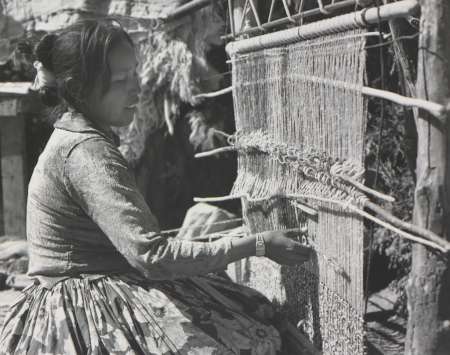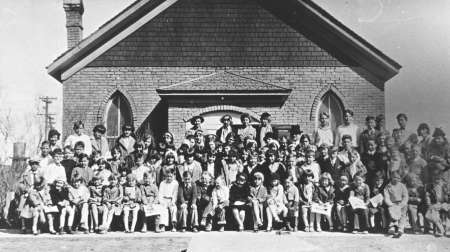- First Mesa
- Second Mesa
- Third Mesa
- Keams Canyon and Other Villages
- Hopi Art and Crafts
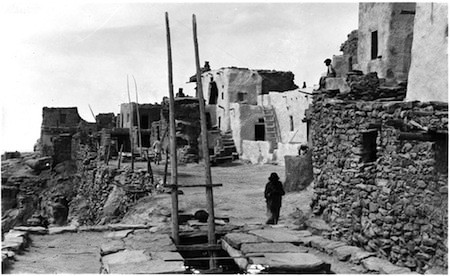
Walpi
Walpi is a significant Native American site that represents traditional Hopi architecture and identity. It is one of eleven occupied Hopi settlements. Unlike the other villages, Walpi still does not have running water or electricity.
This village was moved to its current location as a defensive measure after the Pueblo Revolt of 1680. Over the years the population has slowly dwindled as tribal members move to more contemporary housing. Today, Walpi is most commonly used for public ceremonies.
Repository Northern Arizona University Cline Library
Call Number: NAU.PH.346
Item Number: 150536
Photo from http://archive.library.nau.edu
photo id: 1018
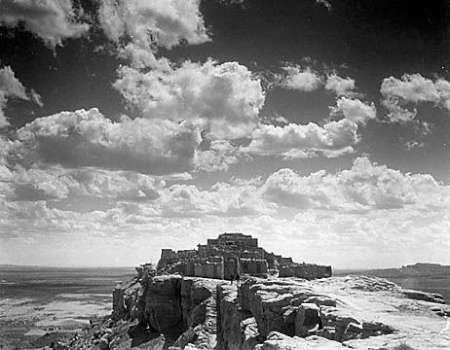
Old Walpi
This photograph of Walpi was taken in 1911.
Collection: Crane, Leo
Repository Northern Arizona University Cline Library
Call Number: NAU.PH.658.132
Item Number: 511
Photo from http://archive.library.nau.edu
photo id: 683

Walpi Plaza
Walpi Dance Court in 1905.
Traditional pueblos require a ladder to enter, which is why you can see so many of them here. To enter, you climb a ladder to the lower rooftop. Shorter ladders lead from there to the upper rooms. Collection: Mora, Jo
Repository Northern Arizona University Cline Library
Call Number: NAU.PH.86.1.292
Item Number: 432
Photo from http://archive.library.nau.edu
photo id: 555
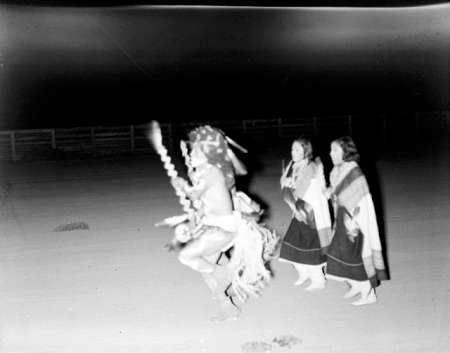
Buffalo Dance
Buffalo Dances are social dances performed by men, women, and children. They deal with fertility, especially the need for winter moisture in the form of snow.
This particular dance was performed at the Navajo Tribal Fairgrounds in Window Rock, Arizona in August 1939.
The Hopi Tribe: Snow, Milton
Repository: Hopi Cultural Preservation Office
Call Number: HCPO.PH.2003.1.HH1.12
Item Number: 26655
Photo from http://archive.library.nau.edu
photo id: 721
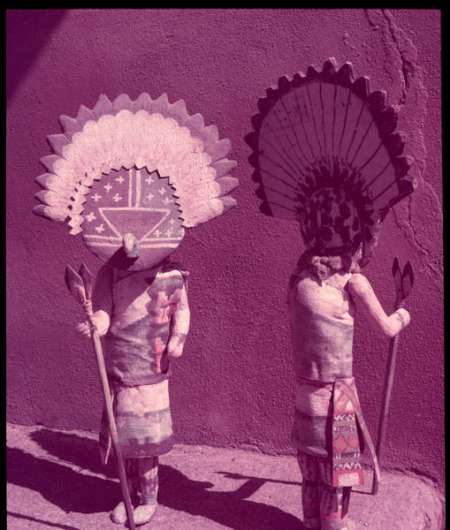
Kachina Dance
This photograph is of Kachina dancers carved from wood. Kachinas appear to the Hopi from the winter solstice on December 21 until mid-July. They dance and sing in unison, symbolizing the harmony of good thought and deed; harmony required for rain to fall and for a balanced life. The rest of the year the kachinas remain in their home in the San Francisco Peaks.
A kachina can take three forms: a powerful unseen spirit, a dancer filled with the spirit, or a wooden figure representing the spirit. Kachina dancers are always male, even when the spirit is female. The men may present gifts of kachina figures to women and children during the dances. Each village sponsors its own ceremonies.
Collection: Muench, Josef
Repository Northern Arizona University Cline Library
Call Number: NAU.PH.2003.11.9.A6080
Item Number: 25661
Photo from http://archive.library.nau.edu
photo id: 722
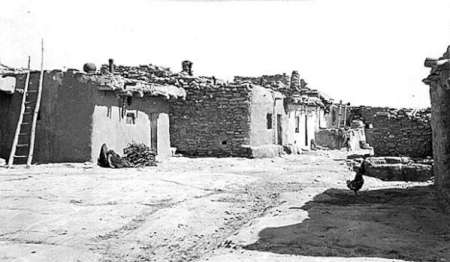
Tewa
Tewa Village, also called Hano, in 1905. This is where most of the Tewa people settled in the eastern part of the Hopi Reservation.
TheArizona Tewa Indians (also Hopi-Tewa, Tano, Southern Tewa, Hano, Thano) are a Tewa Pueblo group. They came to the Hopi as a means of protection for the Hopi people from neighboring raiding tribes such as the Navajo and Apache.
Collection: Mora, Jo
Repository Northern Arizona University Cline Library
Call Number: NAU.PH.86.1.306 Item Number: 408
Photo from http://archive.library.nau.edu
photo id: 556
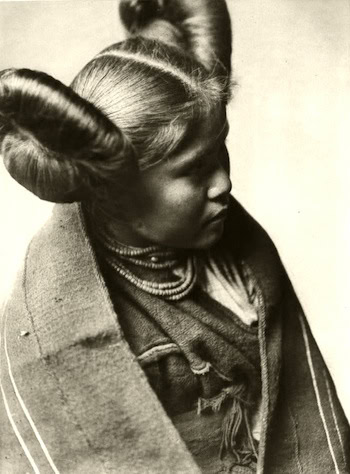
Tewa Female
Chaiwa, a Tewa Indian girl with a butterfly whorl hairstyle, was photographed by Edward S. Curtis in 1922.
There are about 700 Hopi-Tewas, descending mainly from immigrants who settled at First Mesa following the Pueblo Revolt around 1700. They speak a variety of Tewa, a Tanoan language, and have distinct cultural attributes.
photo id: 1017

Dancing
Arrow Dance. Taken in August 1939.
The Hopi Tribe: Snow, Milton
Repository: Hopi Cultural Preservation Office
Call Number: HCPO.PH.2003.1.HH1.10
Item Number: 26652
Photo from http://archive.library.nau.edu
photo id: 720
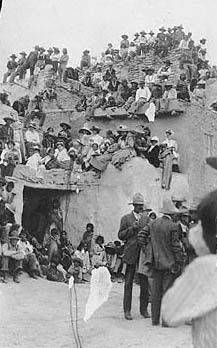
Spectators
A crowd gathers to watch a ceremony in Walpi in 1911.
Collection: Yost, Billie
Repository Northern Arizona University Cline Library
Call Number: NAU.PH.90.44.24
Item Number: 7695
Photo from http://archive.library.nau.edu
photo id: 1024
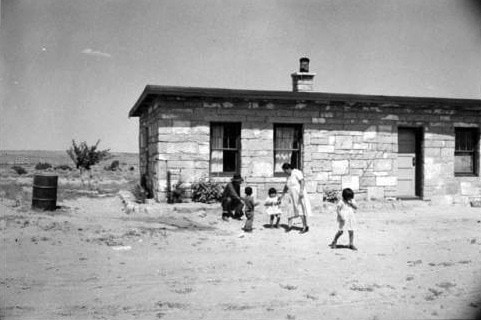
Polacca Farm
The Polacca Farm on the Wepo Wash. Aug. 30, 1945.
The Hopi Tribe: Snow, Milton
Repository: Hopi Cultural Preservation Office
Call Number: HCPO.PH.2003.1.HE2.4
Item Number: 27461
Photo from http://archive.library.nau.edu
photo id: 816
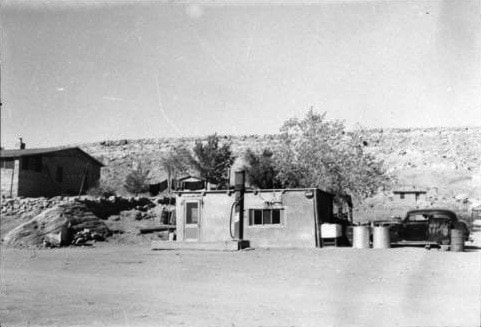
Polacca Store
Gas pump and automobile at the Polacca store in 1940.
The Hopi Tribe: Snow, Milton
Repository: Hopi Cultural Preservation Office
Call Number: HCPO.PH.2003.1.HL7.3
Item Number: 26920
Photo from http://archive.library.nau.edu
photo id: 817
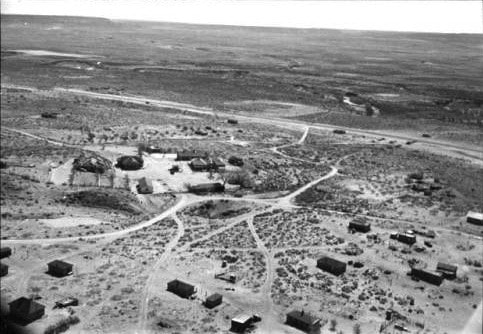
Polacca School
An areal photo of the Polacca Day School in 1954.
The Hopi Tribe: Snow, Milton
Repository: Hopi Cultural Preservation Office
Call Number: HCPO.PH.2003.1.HF3.7
Item Number: 27675
Photo from http://archive.library.nau.edu
photo id: 819
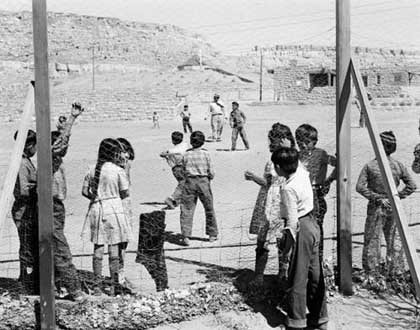
Recreation
Recreation at the Polacca Day School in the spring of 1944.
The Hopi Tribe: Snow, Milton
Repository: Hopi Cultural Preservation Office
Call Number: HCPO.PH.2003.1.HF3.1
Item Number: 26951
Photo from http://archive.library.nau.edu
photo id: 823
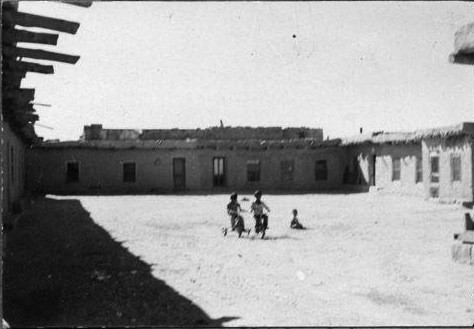
Sitsomovi Village Plaza
Children play in Sitsomovi Village Plaza. This was taken in 1940.
The Hopi Tribe: Snow, Milton
Repository: Hopi Cultural Preservation Office
Call Number: HCPO.PH.2003.1.HL7.1
Item Number: 26916
Photo from http://archive.library.nau.edu
photo id: 824
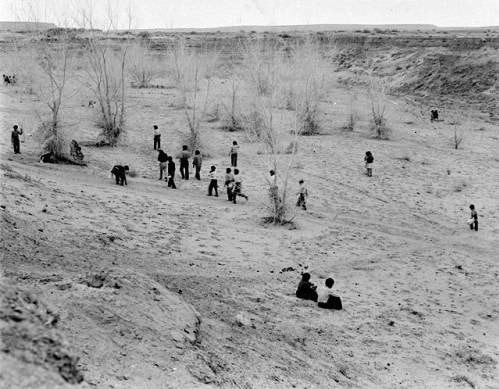
Easter Egg Hunt
School children participate in an Easter Egg Hunt at the Polacca Day School in 1944.
The Hopi Tribe: Snow, Milton
Repository: Hopi Cultural Preservation Office
Call Number: HCPO.PH.2003.1.HF3.3
Item Number: 26953
Photo from http://archive.library.nau.edu
photo id: 825
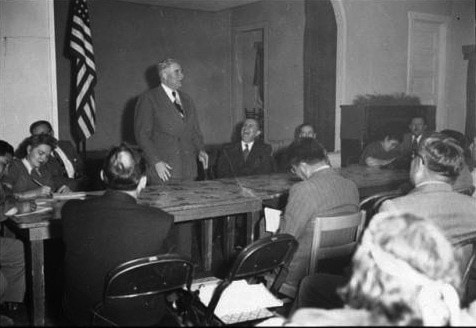
Secretary of the Interior
A public meeting with the Secretary of the Interior, Oscar Chapman. Taken circa 1944.
The Hopi Tribe: Snow, Milton
Repository: Hopi Cultural Preservation
Office Call Number: HCPO.PH.2003.1.HN5.3.11.1
Item Number: 26874
Photo from http://archive.library.nau.edu
photo id: 829
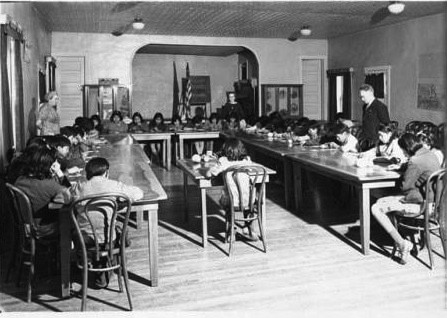
Classroom
A classroom at Toreva Day School, circa 1944.
The Hopi Tribe: Snow, Milton
Repository: Hopi Cultural Preservation Office
Call Number: HCPO.PH.2003.1.HN5.3.1
Item Number: 26711
Photo from http://archive.library.nau.edu
photo id: 830
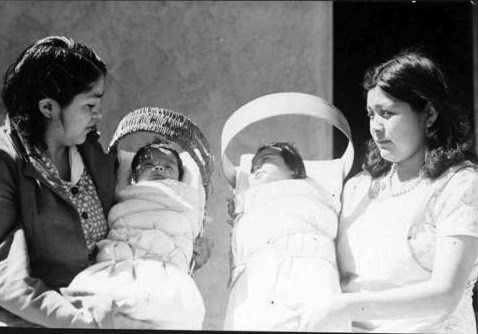
Cradle Boards
Two women with babies in cradle boards. Taken in Tewa Village, First Mesa, 1944.
The Hopi Tribe: Snow, Milton
Repository: Hopi Cultural Preservation Office
Call Number: HCPO.PH.2003.1.HN1.16
Item Number: 29410
Photo from http://archive.library.nau.edu
photo id: 831
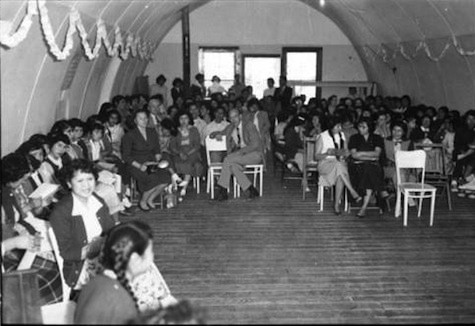
4-H Club Achievement Day
Parents, teachers, friends, Home Economists and 4-H members at the Hopi Reservation 4-H Club Achievement Day held at Polacca Day School in 1954.
The Hopi Tribe: Snow, Milton
Repository: Hopi Cultural Preservation Office
Call Number: HCPO.PH.2003.1.NF.17.567
Item Number: 29343
Photo from http://archive.library.nau.edu
photo id: 832
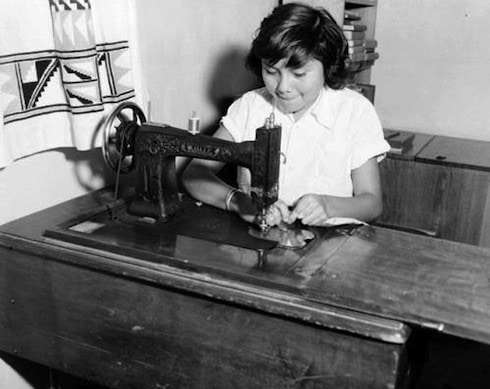
4-H Club Sewing
A member of the Polacca Day School 4-H Club sewing. This was taken in 1954.
The Hopi Tribe: Snow, Milton
Repository: Hopi Cultural Preservation Office
Call Number: HCPO.PH.2003.1.NF.17.574
Item Number: 26631
Photo from http://archive.library.nau.edu
photo id: 833
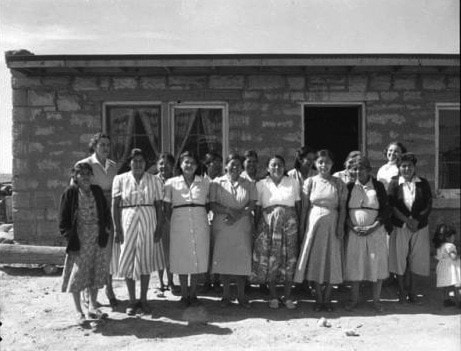
Polacca U-Needa Stitch Club
The Polacca U-Needa Stitch Homemakers Club in 1954.Some of the people in this photo are Marcella Kahe, Lorena Pongyesva, Mrs. Shula and Vivian Mumrwa.
The Hopi Tribe: Snow, Milton
Repository: Hopi Cultural Preservation Office
Call Number: HCPO.PH.2003.1.NF.17.507
Item Number: 29315
Photo from http://archive.library.nau.edu
photo id: 834
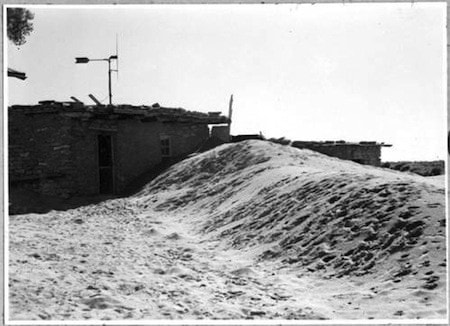
Laurence House
Laurence House at Five Houses. Taken in 1945.
The Hopi Tribe: Snow, Milton
Repository: Hopi Cultural Preservation Office
Call Number: HCPO.PH.2003.1.HE2.11
Item Number: 27470
Photo from http://archive.library.nau.edu
photo id: 858
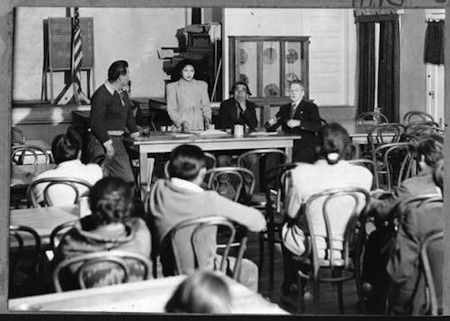
Mishangnovi and Supalovi Meeting
Meeting of Mishangnovi and Supalovi people at theToreva Day School. The community meeting was to discuss the subject of forming of a parent teachers association in March 1944. Included i the photo are Andy Selestewa and Lucy Coowikvaya.
The Hopi Tribe: Snow, Milton
Repository: Hopi Cultural Preservation Office
Call Number: HCPO.PH.2003.1.HN5.3
Item Number: 26709
Photo from http://archive.library.nau.edu
photo id: 859

Shungopavi
Located three miles from the Hopi Cultural Center, this is one of three villages at Second Mesa.Second Mesa is known for its coil baskets.
There are three villages that participate in this type of art: Mishongnovi, Shungopavi, and Shipaulovi.
Collection: Mora, Jo
Repository Northern Arizona University Cline Library
Call Number: NAU.PH.86.1.517
Item Number: 446
Photo from http://archive.library.nau.edu
photo id: 1019
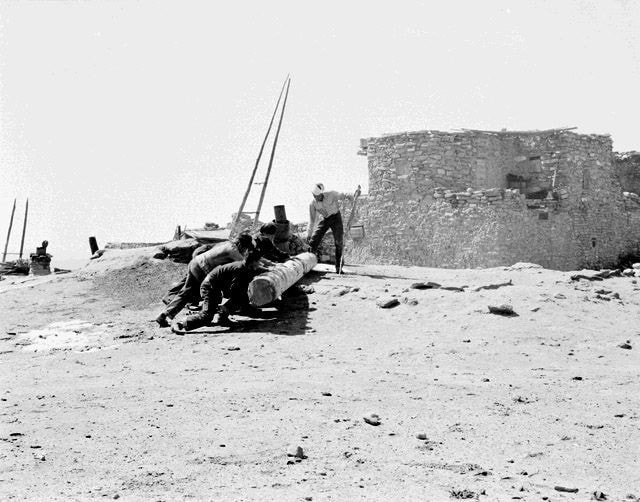
Shungopavi
Men rolling a log into position for repairing a Kiva roof inShungopavi Village.
The Hopi Tribe: Snow, Milton
Repository: Hopi Cultural Preservation Office
Call Number: HCPO.PH.2003.1.HH3.48
Item Number: 26672
Photo from http://archive.library.nau.edu
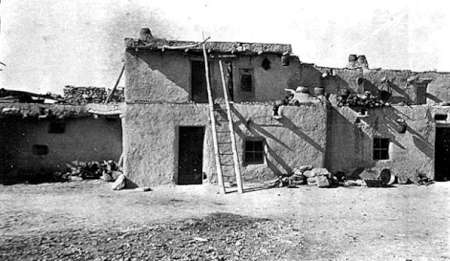
Shungopavi
This photo of Shungopavi was taken in 1905.
Collection: Mora, Jo
Repository Northern Arizona University Cline Library
Call Number: NAU.PH.86.1.522
Item Number: 449
Photo from http://archive.library.nau.edu
photo id: 554
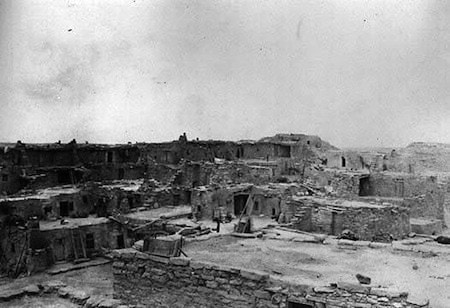
Mishongnovi
Mishongnovi is one of the villages in Second Mesa. In most Hopi areas it is not permissible to take photographs or video. Sadly, illegal photography and a lack of respect for the traditions and ceremonial practices has led to the decision to bar non-natives from attending many Hopi ceremonies.
The Snake Dance is part of an elaborate days-long ceremony in which tribal members pray for rain. The Snake Dance is held alternately at the Hopi villages of Mishongnovi and Shungopavi each year.
The Hopi Tribe: Young, Stuart Malcolm
Repository: Hopi Cultural Preservation Office
Call Number: NAU.PH.643.3.46
Item Number: 1494
Photo from http://archive.library.nau.edu
photo id: 1020
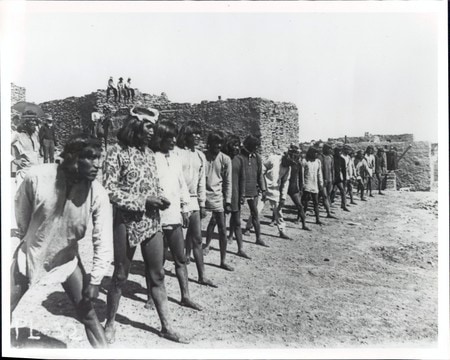
Hopi Footrace
It is said that some of the best long distance runners have received little or no recognition, possibly because they have never run publicly outside the Hopi community.
When speaking with Anna Silas from the Hopi Museum at the Cultural Center about Hopi athletes, she spoke of the Hopi runner Louis Tewanima. Tewanima is one of the most celebrated runners in Hopi history and is best known for winning a silver medal at the 1912 Olympic Games. Anna inducted Tewanima to the National Hall of Famous American Indians in Anadarco, OK in the 1980s.
The annual Louis Tewanima Footrace is held at the Village of Shungopavi on Second Mesa. Tewanima’s legacy continues to inspire many individuals to enjoy the sport of running.
photo id: 82
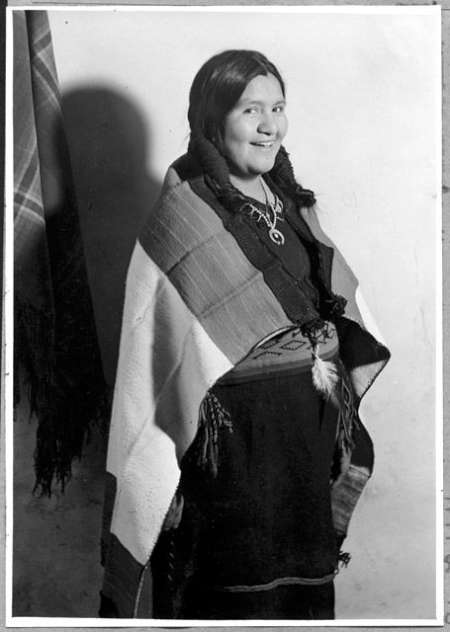
Married Women of the Hopi Tribes
Once a Hopi woman is married, she must either wear her hair down or in braids. This indicates that she is no longer available. They are also presented with the dress and waistband pictured here on their wedding day.
The woman in this photo is Eleanor Quyo. It was taken in Mishongnovi Village in March 1944.
The Hopi Tribe: Snow, Milton
Repository: Hopi Cultural Preservation Office
Call Number: HCPO.PH.2003.1.HH2.18
Item Number: 29463
Photo from http://archive.library.nau.edu
photo id: 724
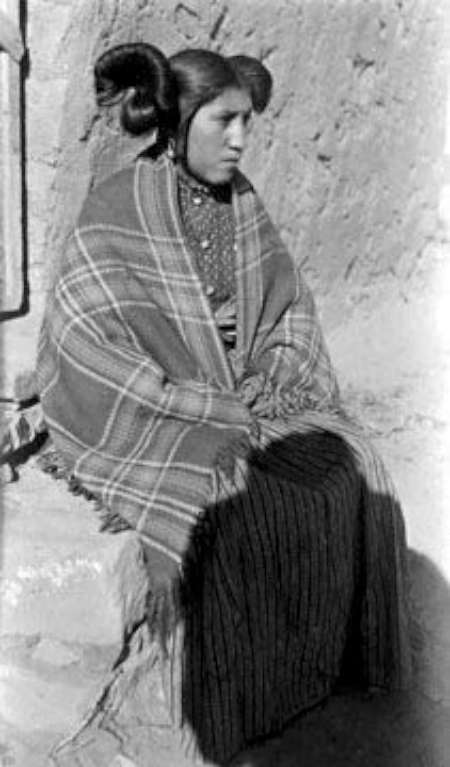
Hopi Maiden
Hopi girls go through a four-day ceremony after reaching womanhood. After the ceremony their hair is worn in side buns to indicate that they are ready for marriage.
This photograph was taken in 1905.
Collection: Mora, Jo
Repository Northern Arizona University Cline Library
Call Number: NAU.PH.86.1.75
Item Number: 391
Photo from http://archive.library.nau.edu
photo id: 723
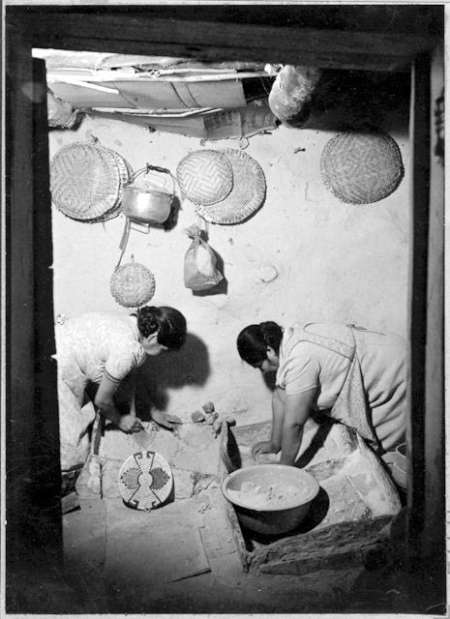
Grinding Corn
Women grinding corn to make piki in Mishongnovi Villave, 1944.
The Hopi Tribe: Snow, Milton
Repository: Hopi Cultural Preservation Office
Call Number: HCPO.PH.2003.1.HH3.46
Item Number: 29850
Photo from http://archive.library.nau.edu
photo id: 670
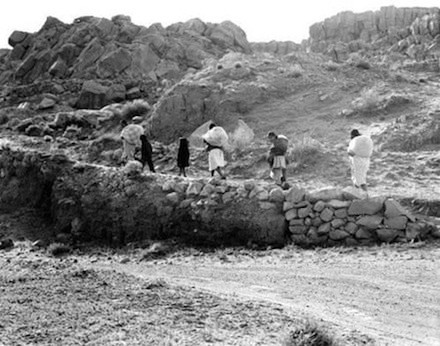
Laundry
Women carrying laundry to the village from the day school in Shungopavi. April 1944.
The Hopi Tribe: Snow, Milton
Repository: Hopi Cultural Preservation Office
Call Number: HCPO.PH.2003.1.HH3.23
Item Number: 26666
Photo from http://archive.library.nau.edu
photo id: 814
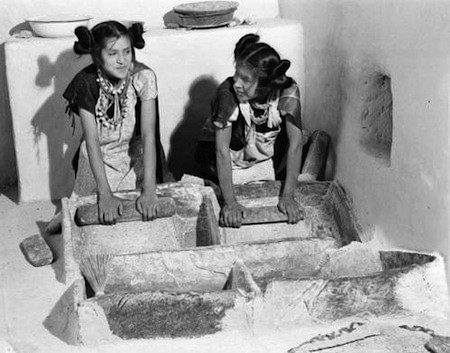
Grinding Corn
Two young girls grind corn during a Puberty Ceremony in Shungopovi Village in 1949. On the left is Belvera Nuvamsa; on the right is Mary Anna Nuvakaku. According to the Smithsonian Institute, this ceremony begins with a special prayer on the summer solstice. On the second day of the ceremony the young woman will begin grinding corn and fasting for four days. This teaches her that being a woman is precious but hard work.
The Hopi Tribe: Snow, Milton
Repository: Hopi Cultural Preservation Office
Call Number: HCPO.PH.2003.1.HH1.3
Item Number: 26642
Photo from http://archive.library.nau.edu
photo id: 815
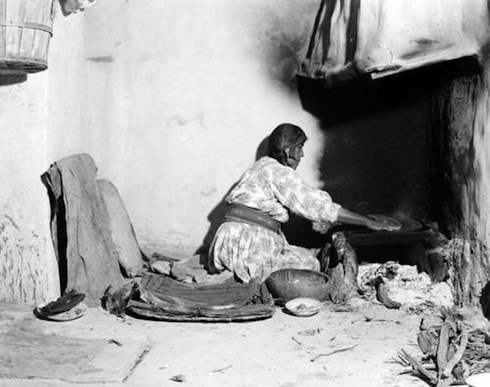
Making Piki
Blanch Tewanima making piki in Shungopavi Village. This was taken in 1944.
The Hopi Tribe: Snow, Milton
Repository: Hopi Cultural Preservation Office
Call Number: HCPO.PH.2003.1.HH3.27
Item Number: 26669
Photo from http://archive.library.nau.edu
photo id: 835
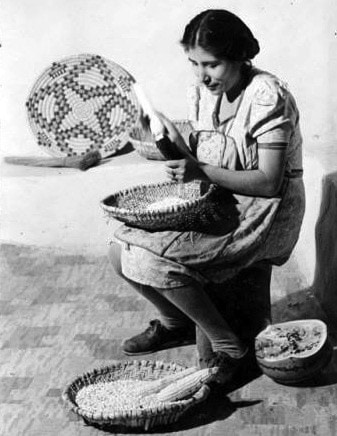
Shelling Corn
Mardell Shingoitewain in Mishongnovi shelling corn in 1944.
The Hopi Tribe: Snow, Milton
Repository: Hopi Cultural Preservation Office
Call Number: HCPO.PH.2003.1.HH3.2
Item Number: 29487
Photo from http://archive.library.nau.edu
photo id: 840
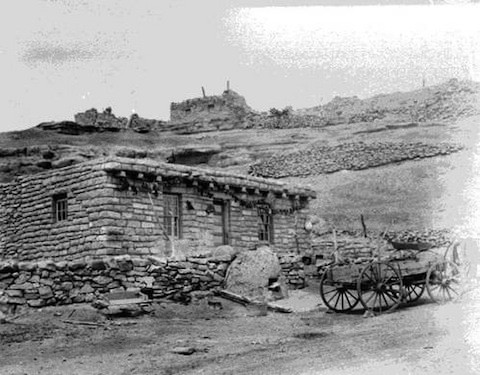
Dennis House
The home of Edith and Alex Dennis in Mishongnovi Village. This was taken in 1944.
The Hopi Tribe: Snow, Milton
Repository: Hopi Cultural Preservation Office
Call Number: HCPO.PH.2003.1.HE3.58
Item Number: 26675
Photo from http://archive.library.nau.edu
photo id: 841
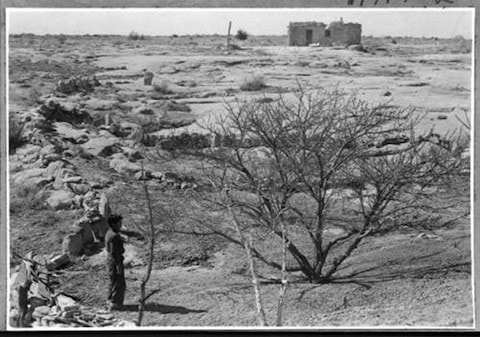
Peach Trees
Peach trees, owned by Clara and Glen Joswytewas, near Shungopavi Village. This was taken in 1944.
The Hopi Tribe: Snow, Milton
Repository: Hopi Cultural Preservation Office
Call Number: HCPO.PH.2003.1.HA7.2
Item Number: 27571
Photo from http://archive.library.nau.edu
photo id: 842
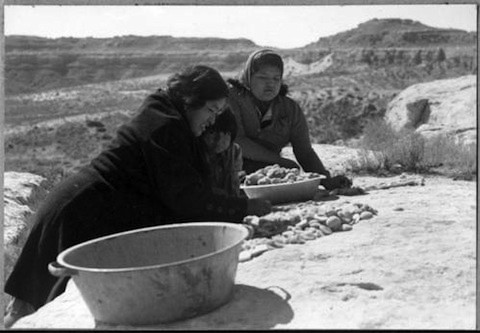
Drying Peaches
Two women drying peaches: Hollis Seletstewa and Elizabeth Seletstewa. This was taken in Mishongnovi Village in 1944.
The Hopi Tribe: Snow, Milton
Repository: Hopi Cultural Preservation Office
Call Number: HCPO.PH.2003.1.HH3.45
Item Number: 29849
Photo from http://archive.library.nau.edu
photo id: 843
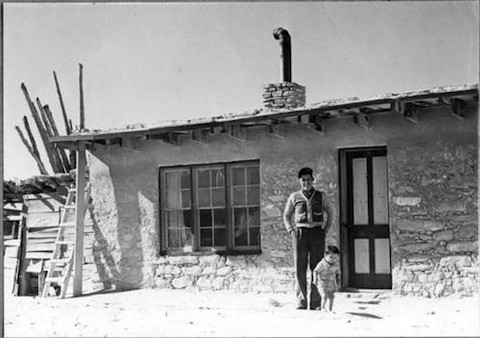
Sammy B’s Store
Arle Nuvayouma and Arlance Nuvayouma in front of Sammy B’s store in Shungopavi Village. This was taken in 1944.
The Hopi Tribe: Snow, Milton
Repository: Hopi Cultural Preservation Office
Call Number: HCPO.PH.2003.1.HE3.28
Item Number: 27058
Photo from http://archive.library.nau.edu
photo id: 844
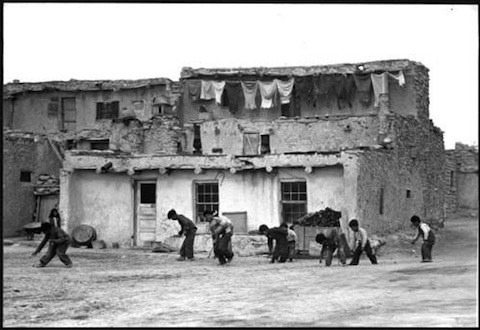
Spinning Tops
Boys spinning Hopi tops. Shungopavi Village-Second Mesa. March 1944
The Hopi Tribe: Snow, Milton
Repository: Hopi Cultural Preservation Office
Call Number: HCPO.PH.2003.1.HE3.51
Item Number: 27172
Photo from http://archive.library.nau.edu
photo id: 845
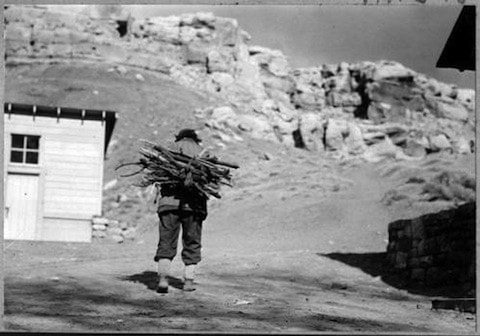
Carrying Firewood
Carrying firewood to Mishongnovi.
The Hopi Tribe: Snow, Milton
Repository: Hopi Cultural Preservation Office
Call Number: HCPO.PH.2003.1.HH3.18
Item Number: 29507
Photo from http://archive.library.nau.edu
photo id: 846
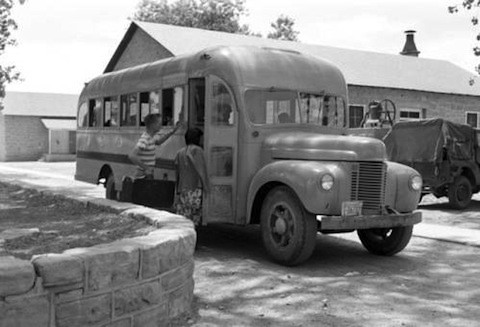
Bus to California
Children leaving Shungopavi Day School for a two week visit with families on the California coast. This was a Friends Society Project in 1944.
The Hopi Tribe: Snow, Milton
Repository: Hopi Cultural Preservation Office
Call Number: HCPO.PH.2003.1.HF5.37
Item Number: 29015
Photo from http://archive.library.nau.edu
photo id: 847

Supply Truck
Children watch supplies being unloaded at Shungopavi Day School in 1944.
The Hopi Tribe: Snow, Milton Repository: Hopi Cultural Preservation Office Call Number: HCPO.PH.2003.1.HF5.3 Item Number: 28950 Photo from http://archive.library.nau.edu
photo id: 848
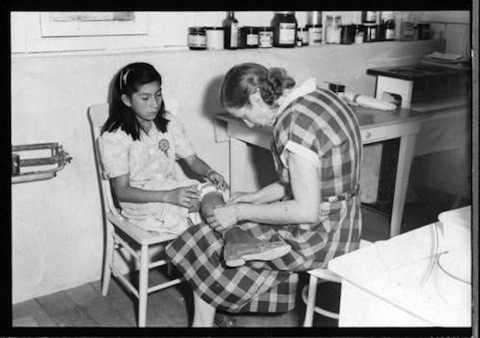
Toreva Clinic
The Toreva School Clinic in 1950.
The Hopi Tribe: Snow, Milton
Repository: Hopi Cultural Preservation Office
Call Number: HCPO.PH.2003.1.HJ3.10
Item Number: 27917
Photo from http://archive.library.nau.edu
photo id: 849
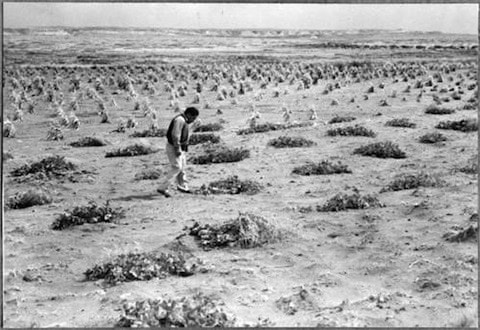
Corn and Melon Field
In this picture are corn and melons on Sam Shingoitewa’s farm, 15 miles southwest of Toreva Day School. It was taken in 1944.
Agriculture and grazing are important activities for Hopi. They perceive agriculture, particularly corn growing, from a different perspective than academics. The Hopi believe that when they advanced from the third to the fourth way of life, they received corn from Ma’saw. While the other people chose the largest ears of the corn, the Hopis selected the shortest blue ear corn.
From that time on, corn has occupied a significant position in the Hopi society and culture. To the Hopi, agriculture is a way of life. Moreover, their ceremonies mark the different phases of the Hopi agricultural cycle.
The Hopi Tribe: Snow, Milton
Repository: Hopi Cultural Preservation Office
Call Number: HCPO.PH.2003.1.HA3.4
Item Number: 27753
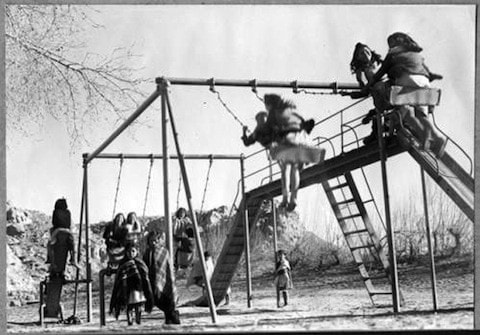
Recess
Shungopavi Day School students enjoying their recess. This was taken in 1944.
The Hopi Tribe: Snow, Milton
Repository: Hopi Cultural Preservation Office
Call Number: HCPO.PH.2003.1.HF5.2
Item Number: 28802
Photo from http://archive.library.nau.edu
photo id: 851
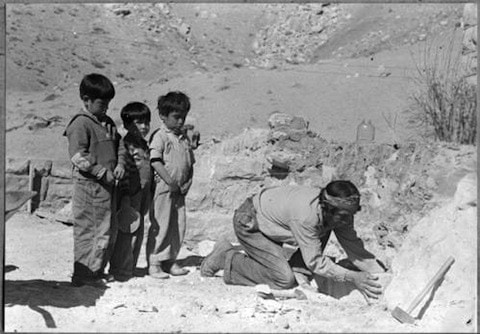
Volunteerism
Several people volunteering for Toreva Day School in 1944. From left to right are: Ivan Seletstewa, Joseph Seletstewa, Edward Masaytewa, and Andy Seletstewa.
The Hopi Tribe: Snow, Milton
Repository: Hopi Cultural Preservation Office
Call Number: HCPO.PH.2003.1.HF4.13
Item Number: 28042
Photo from http://archive.library.nau.edu
photo id: 852
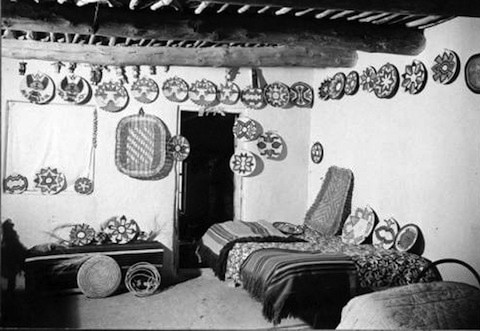
Home Interior
The interior of Archie and Nellie Quamala’s house in Shungopavi Village in 1944.
The Hopi Tribe: Snow, Milton
Repository:
Hopi Cultural Preservation Office
Call Number: HCPO.PH.2003.1.HC2.4
Item Number: 29843
Photo from http://archive.library.nau.edu
photo id: 853
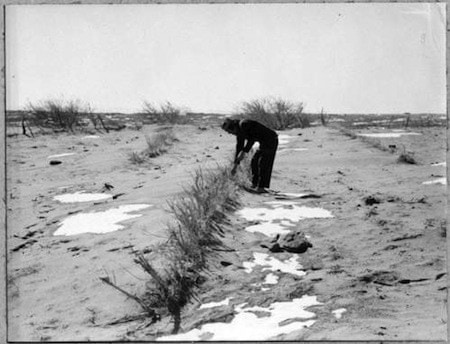
Farm Plot
A farm plot with rows of toviga to keep the soil from blowing away. It was taken near Shungopavi Village in 1949. In the photo is Viets Lomahaftewa.
The Hopi Tribe: Snow, Milton
Repository: Hopi Cultural Preservation Office
Call Number: HCPO.PH.2003.1.HA3.6
Item Number: 27754
Photo from http://archive.library.nau.edu
photo id: 854
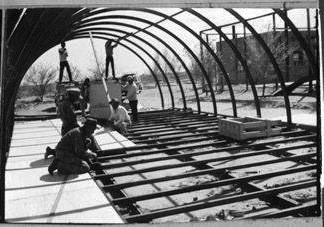
Quonset Hut
Erecting a quonset hut for the Hopi Arts & Crafts Guild. The foreman was Sam Shing [Shingoitewa]. This was taken in 1947.
The Hopi Tribe: Snow, Milton
Repository: Hopi Cultural Preservation Office
Call Number: HCPO.PH.2003.1.HE3.67
Item Number: 27338
Photo from http://archive.library.nau.edu
photo id: 855
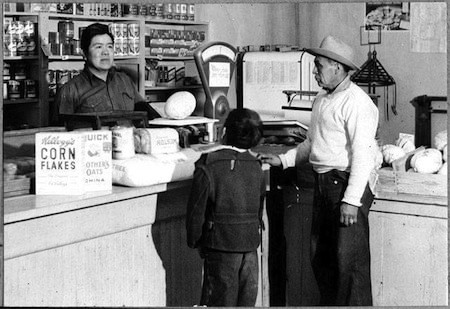
Sekukaku’s Store
Hale Sekukaku’s store, located between Mishongnovi and Shipaulovi. This was taken in 1944.
The Hopi Tribe: Snow, Milton
Repository: Hopi Cultural Preservation Office
Call Number: HCPO.PH.2003.1.HE3.2
Item Number: 26853
Photo from http://archive.library.nau.edu
photo id: 856
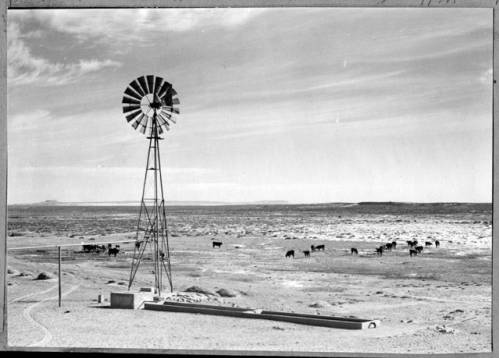
Cattle
Hopi cattle, south of Second Mesa. This was taken in 1944.
The Hopi Tribe: Snow, Milton
Repository: Hopi Cultural Preservation Office
Call Number: HCPO.PH.2003.1.HM2.1
Item Number: 28579
Photo from http://archive.library.nau.edu
photo id: 857
/med
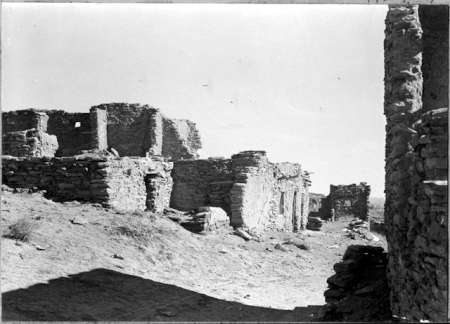
Old Oraibi Ruins
Old Oraibi on Third Mesa is thought to be the oldest settlement in the new world. It is located on top of Third Mesa, just above the town of Kykotsmovi, the tribal government seat. Old Oraibi is governed by a village chief and chooses not to have any representatives on the Hopi Tribal Council. The village also does not have any village administration and rejects any funding allocated to Hopi villages by the Tribal government.
Old Oraibi was established in 1100 A.D and was designated a historical landmark on July 19, 1964. Located on the westernmost of the Hopi mesas, this is probably the oldest continuously inhabited pueblo in North America.This particular photograph was taken in 1944.
The Hopi Tribe: Snow, Milton
Repository: Hopi Cultural Preservation Office
Call Number: HCPO.PH.2003.1.HE4.7
Item Number: 26665
Photo from http://archive.library.nau.edu
photo id: 686
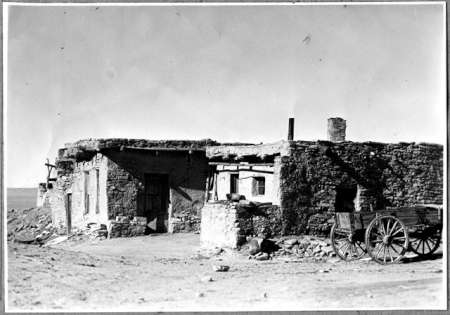
Homes in Old Oraibi
Houses in Old Oraibi Village in 1944.
The Hopi Tribe: Snow, Milton
Repository: Hopi Cultural Preservation Office
Call Number: HCPO.PH.2003.1.HE4.2
Item Number: 26657
Photo from http://archive.library.nau.edu
photo id: 685
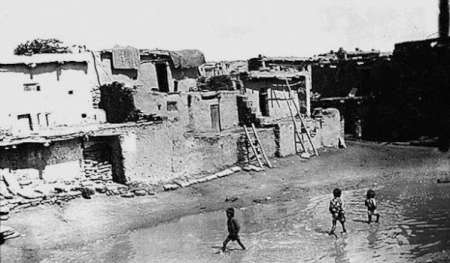
Oraibi Village
Children play in Oraibi Village in 1905.Collection: Mora, Jo
Repository Northern Arizona University Cline Library
Call Number: NAU.PH.86.1.484
Item Number: 379
Photo from http://archive.library.nau.edu
photo id: 708
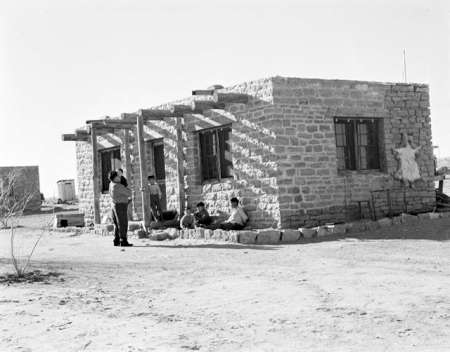
Moencopi Home
Sam Shingoitewa’s house in Moencopi (Moenkopi) Village in 1944.
The Hopi Tribe: Snow, Milton
Repository: Hopi Cultural Preservation Office
Call Number: HCPO.PH.2003.1.HE5.1
Item Number: 26637
Photo from http://archive.library.nau.edu
photo id: 684

Moencopi Home
Sam Shingoitewa’s house in Moencopi (Moenkopi) Village in 1944.
The Hopi Tribe: Snow, Milton
Repository: Hopi Cultural Preservation Office
Call Number: HCPO.PH.2003.1.HE5.1
Item Number: 26637
Photo from http://archive.library.nau.edu
photo id: 684
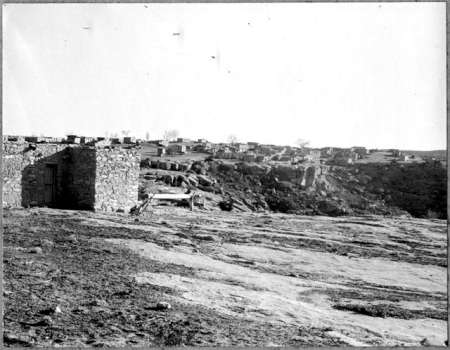
Hotevilla Village
The first major dispute occurred in 1906 between two chiefs, You-ke-oma and Tawa-quap-tewa. Instead of fighting with bullets or arrows, the leaders staged a “push-of-war” contest. A line was cut into the mesa and the two groups stood on either side. They pushed against each other as hard as they could until Tawa-quap-tewa’s group crossed the line and won. You-ke-oma, the loser, left with his faction to establish Hotevilla four miles away. This event was recorded a quarter mile north of Oraibi with the line and inscription: “Well, it have to be done this way now, that when you pass this LINE it will be DONE, Sept. 8, 1906.” A bear paw cut in the rock is the symbol of Tawa-quap-tewa and his Bear Clan, while a skull represents You-ke-oma and his Skeleton Clan. Other residents split off to join New Oraibi at the foot of the mesa.
The Hopi Tribe: Snow, Milton
Repository: Hopi Cultural Preservation Office
Call Number: HCPO.PH.2003.1.HE4.11
Item Number: 26671
Photo from http://archive.library.nau.edu
photo id: 689
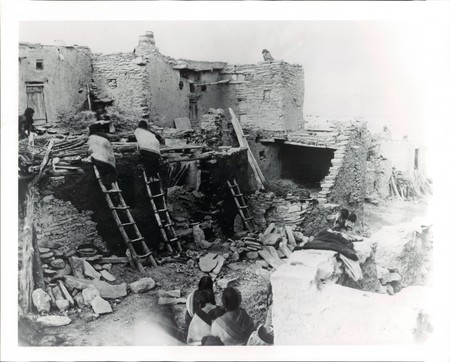
Hopi Woman Builders
Pictured here are Hopi women. Traditionally it was the women who did the building. Therefore, they own their homes and are the head of the family. Men assisted with the heavy lifting and occasionally even helped with the masonry work. Even today the walls are still hand-plastered by women.
A typical home was built using hand-trimmed sandstone and earth and grew organically over the centuries. The roofs consist of vigas (structural beams), latillas (branches used as sheathing), and a capping layer of willow twigs and earth.
The ancestral home is very dear to the Hopi hearts of men, women, and children alike.
photo id: 81
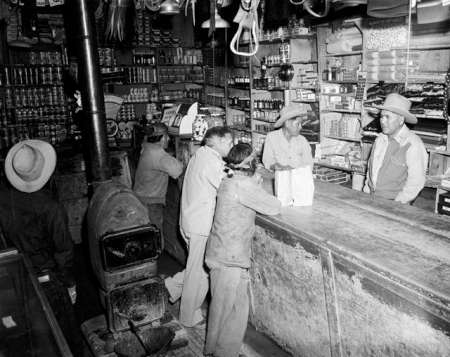
Hubbell Store
The old Hubbell Trading Post in Oraibi. In the picture are Horace Kwani and George Sankey. This was taken in 1948.
The Hopi Tribe: Snow, Milton
Repository: Hopi Cultural Preservation Office
Call Number: HCPO.PH.2003.1.HE4.25
Item Number: 26635
Photo from http://archive.library.nau.edu
photo id: 688
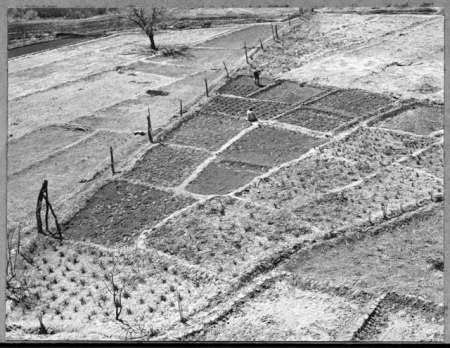
Terraced fields
This image is of the subjugated farmland along South Oraibi Wash, 9 miles above Oraibi Village. Even with its sporadic water supply, the desert wash allows the surrounding land to be considered as suitable for farming.
The Hopi Tribe: Snow, Milton
Repository: Hopi Cultural Preservation Office
Call Number: HCPO.PH.2003.1.HA4.4
Item Number: 27572
Photo from http://archive.library.nau.edu
photo id: 691
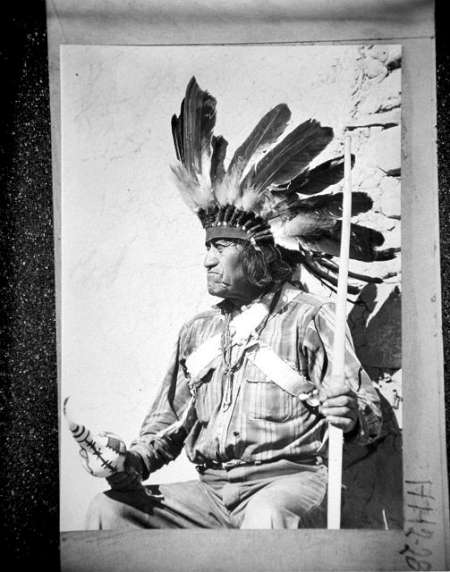
Hopi Chief Tewaquaptewa
Chief Quaptewa (Tewaquaptewa) in his tourist regalia in Oraibi Village in 1944.
The Hopi Tribe: Snow, Milton
Repository: Hopi Cultural Preservation Office
Call Number: HCPO.PH.2003.1.HH2.28
Item Number: 26658
Photo from http://archive.library.nau.edu
photo id: 692

Youkeoma Arrest
The arrest of Youkeoma in 1915.
Collection: Crane, Leo
Repository Northern Arizona University Cline Library
Call Number: NAU.PH.658.304
Item Number: 557
Photo from http://archive.library.nau.edu
photo id: 693
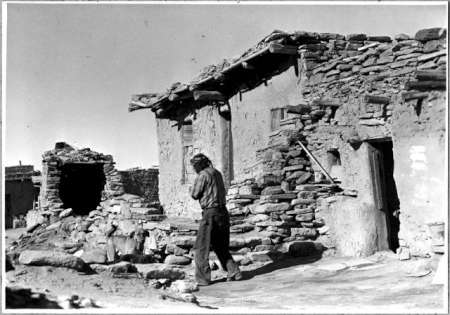
Chief Tewaquaptewa
Chief Quaptewa (Tewaquaptewa) and his house in Old Oraibi Village. Taken in 1944.
Repository: Hopi Cultural Preservation Office
The Hopi Tribe: Snow, Milton
Call Number: HCPO.PH.2003.1.HE4.3
Item Number: 26659
Photo from http://archive.library.nau.edu
photo id: 696

Chief Tawaquadtewa
Chief Tawaquaptewa in his tourist costume in Oraibi Village. This was taken in March 1944.
The Hopi Tribe: Snow, Milton
Repository: Hopi Cultural Preservation Office
Call Number: HCPO.PH.2003.1.HH2.20
Item Number: 29467
Photo from http://archive.library.nau.edu
photo id: 707

Hotevilla Village with scenes
Crane, Leo
Repository: Northern Arizona University Cline Library
Call Number: NAU.PH.658.200
Item Number: 540
Photo from http://archive.library.nau.edu
photo id: 709
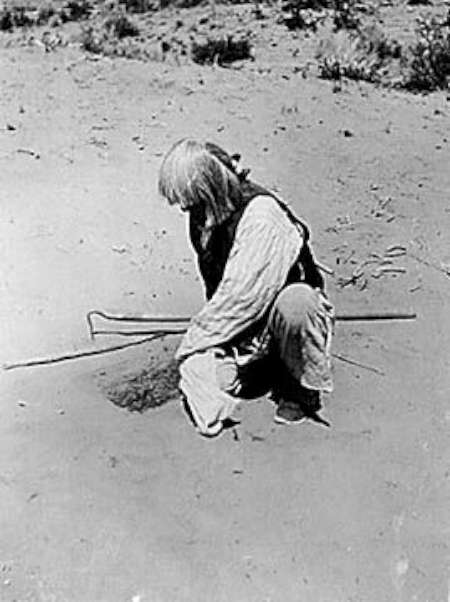
Corn planter at Bacabi
A corn planter in Bacabi in 1914. Crane, Leo
Repository: Northern Arizona University Cline Library
Call Number: NAU.PH.658.309
Item Number: 559
Photo from http://archive.library.nau.edu
photo id: 710

Trading Post
Oraibi Trading Post in 1931.The Hopi Tribe: McKee, Barbara or EdwinRepository: Northern Arizona University Cline Library
Call Number: NAU.PH.95.48.502
Item Number: 1594
Photo from http://archive.library.nau.edu
photo id: 711
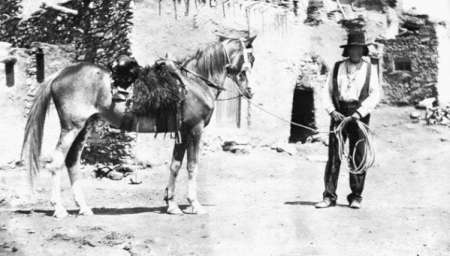
Indian Police at Snake Dance Ceremony
Reservation Police at a snake dance ceremony in Oraibi in 1905.
Collection: Mora, Jo
Repository Northern Arizona University Cline Library
Call Number: NAU.PH.86.1.74
Item Number: 9293
Photo from http://archive.library.nau.edu
photo id: 712
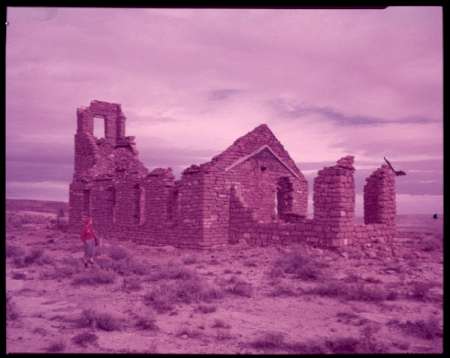
Burned Church
Standing out almost at the extreme tip of the Third Mesa on the Hopi Reservation is this Menonite Mission chapel, erected in 1901 and burned by lightning in 1942.
The Hopi Tribe: Muench, Josef
Repository: Northern Arizona University Cline Library
Call Number: NAU.PH.2003.11.9.B8178
Item Number: 25676
Photo from http://archive.library.nau.edu
photo id: 713
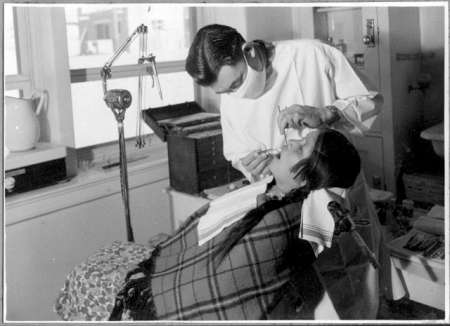
Dentist at high school
Dentist Dr. T. Shimizu and patient Effie James at Hopi High School. Taken in Oraibi, 1945.
The Hopi Tribe: Snow, Milton
Repository: Hopi Cultural Preservation Office
Call Number: HCPO.PH.2003.1.HJ1.2
Item Number: 28146
Photo from http://archive.library.nau.edu
photo id: 714
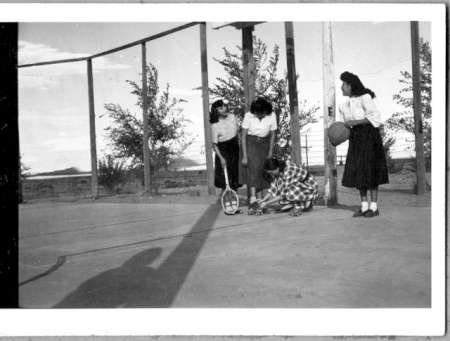
Girls outside sports
Girls and their teacher at Hopi High School in Oraibi outdoors playing sports.
The Hopi Tribe: Snow, Milton
Repository: Hopi Cultural Preservation Office
Call Number: HCPO.PH.2003.1.HF2.57
Item Number: 29270
Photo from http://archive.library.nau.edu
photo id: 716
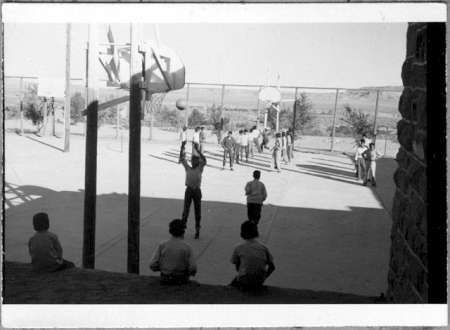
Boys on Basketball court
Boys at Hopi High School in Oraibi playing basketball.
The Hopi Tribe: Snow, Milton
Repository: Hopi Cultural Preservation Office
Call Number: HCPO.PH.2003.1.HF2.41
Item Number: 29193
Photo from http://archive.library.nau.edu
photo id: 718
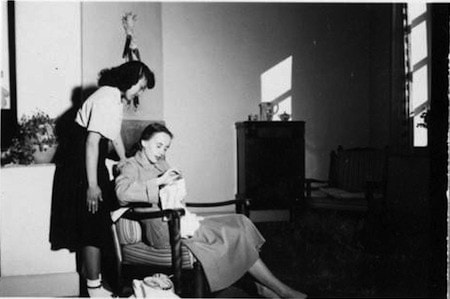
Needlework
A Hopi girl watches her teacher, Miss Barbara Barnett, doing needlework.
The Hopi Tribe: Snow, Milton
Repository: Hopi Cultural Preservation Office
Call Number: HCPO.PH.2003.1.HF2.62
Item Number: 29277
Photo from http://archive.library.nau.edu
photo id: 860
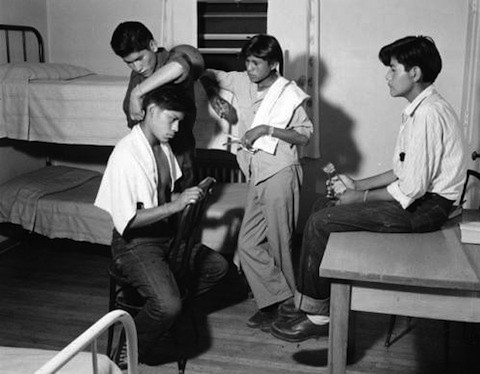
Dormitory Haircut
Boys in their dormitory room at Hopi High School in Oraibi. One of them is getting a haircut.
The Hopi Tribe: Snow, Milton
Repository: Hopi Cultural Preservation Office
Call Number: HCPO.PH.2003.1.HF2.24
Item Number: 26779
Photo from http://archive.library.nau.edu
photo id: 861
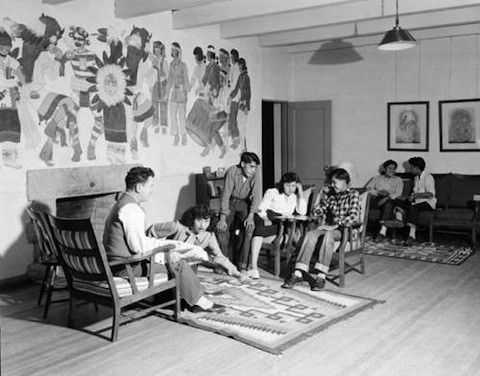
Mural
Students and their teacher in a room at Hopi High School with a beautiful wall mural above the fireplace.
The Hopi Tribe: Snow, Milton
Repository: Hopi Cultural Preservation Office
Call Number: HCPO.PH.2003.1.HF2.27
Item Number: 26783
Photo from http://archive.library.nau.edu
photo id: 862
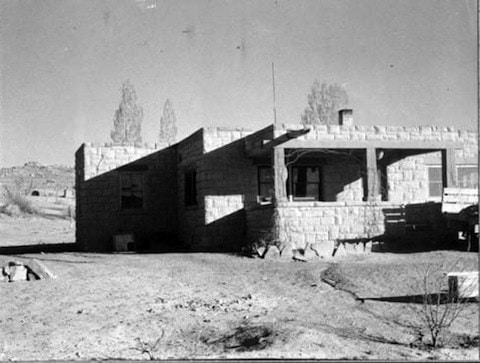
New Oraibi Village
New Oraibi Village in 1944.
The Hopi Tribe: Snow, Milton
Repository: Hopi Cultural Preservation Office
Call Number: HCPO.PH.2003.1.HE4.12
Item Number: 26673
Photo from http://archive.library.nau.edu
photo id: 863
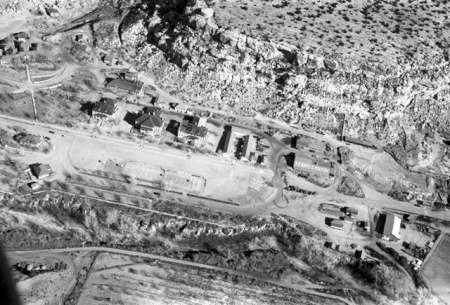
Keams Canyon Aerial View
An aerial view of Keams Canyon in 1948.
While serving in the military in 1863, Thomas V. Keams was sent to an area known as Peach Orchard Spring. Colonel KIt Carson was trying to capture Navajo Indians. When the fighting was over, Thomas spent time as an Indian Agent to the Navajos. After he married a Navajo woman, they returned to Peach Orchard Spring and established a ranch. This area is now known as Keams Canyon.
In 1869, Keams opened a trading post about three miles east of where it is currently located. The current trading post was built in 1879. Business was mostly conducted by bartering with the Indians who traded livestock and wool for flour, sugar, and tobacco. Eventually, Keams began trading for pottery which he took to the train stations and sold to passengers and later to Fred Harvey and Grand Canyon National Park.
The Hopi Tribe: Snow, Milton
Repository: Hopi Cultural Preservation Office
Call Number: HCPO.PH.2003.1.HE1.18.3
Item Number: 28785
Photo from http://archive.library.nau.edu
photo id: 516
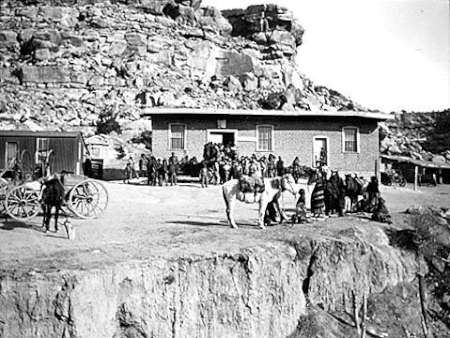
Hubbell’s Store
In 1906 Thomas Keams sold his trading post to Lorenzo Hubbell of Ganado. The trading post is on the Hopi Reservation in Keams Canyon, where Lorenzo was able to work with the tribes to sell their arts and crafts. The excellent workmanship and variety of talent was recognized by Hubbell and he was able to expand his trading post along the rail lines.
Collection: Crane, Leo
Repository: Northern Arizona University Cline Library
Call Number: NAU.PH.658.98
Item Number: 494
Photo from http://archive.library.nau.edu
photo id: 518

Lorenzo Hubbell
Lorenzo Hubbell, trading post owner, in Keams Canyon in 1905.
Collection: Mora, Jo
Repository: Northern Arizona University Cline Library
Call Number: NAU.PH.86.1.398
Item Number: 418
Photo from http://archive.library.nau.edu
photo id: 519
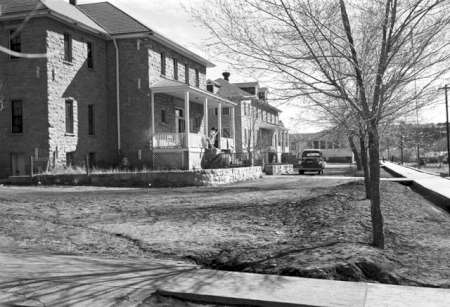
Keams Canyon Boarding School
In 1875, English trader Thomas Keams escorted the Hopi village leaders to meet President Arthur in Washington D.C. Lololoma, acting chief at the time, was very impressed with Washington. He believed that education is what allowed the white man to be able to live in such a way. This belief caused him to want a school built for the Hopi children. In 1886, twenty of the Hopi leaders signed a petition sent to the Commissioner of Indian Affairs requesting that a school be built on their land. In 1887, Thomas Keams opened Keams Canyon Boarding School at Keams Canyon for the Hopi Indians.
The main objective of Keams School was to teach the Hopi youth the ways of civilization by pushing Anglo-American values. The Oraibi people were not supportive of this school. They refused to send their children to a school that was 35 miles away from their villages.
The Hopi Tribe: Snow, Milton
Repository: Hopi Cultural Preservation Office
Call Number: HCPO.PH.2003.1.HE1.40
Item Number: 28800
Photo from http://archive.library.nau.edu
photo id: 521
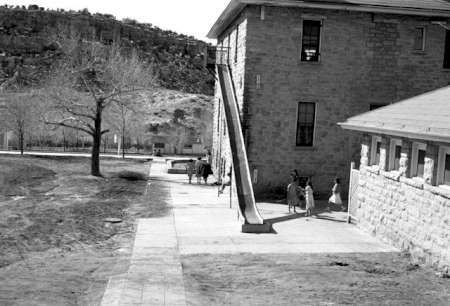
Back of Keams Canyon Boarding School
The children who attended Keams Canyon School received haircuts, new clothes, took on a “white” name, and learned English. The boys learned farming and carpentry skills, while the girls were taught ironing, sewing and “civilized” dining. Keams School also reinforced American religions. The American Baptist Home Missionary Society provided the students with services every morning and religious teachings throughout the week.
The Hopi Tribe: Snow, Milton
Repository: Hopi Cultural Preservation Office
Call Number: HCPO.PH.2003.1.HE1.41
Item Number: 28799
Photo from http://archive.library.nau.edu
photo id: 522
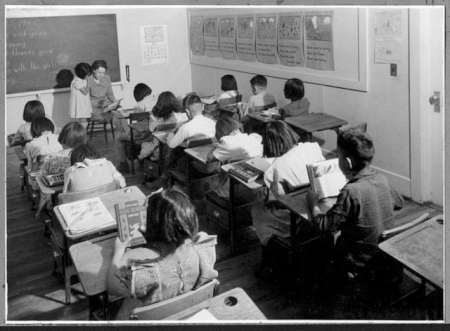
Classroom
Children at their desks in a classroom at Keams Canyon Boarding School.
The Hopi Tribe: Snow, Milton
Repository: Hopi Cultural Preservation Office
Call Number: HCPO.PH.2003.1.HF1.24
Item Number: 28276
Photo from http://archive.library.nau.edu
photo id: 523
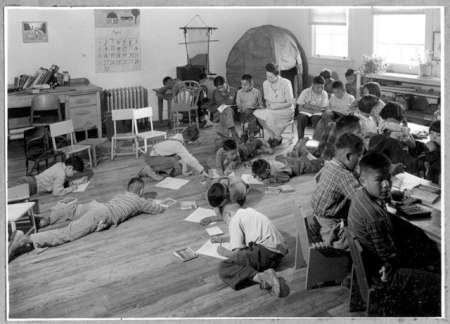
Boys Class
A beginners class at Keams Canyon Boarding School. Mrs. Burton A. Ladd is the teacher. This was taken on April 23, 1943.
The Hopi Tribe: Snow, Milton
Repository: Hopi Cultural Preservation Office
Call Number: HCPO.PH.2003.1.HF1.20
Item Number: 28272
Photo from http://archive.library.nau.edu
photo id: 524
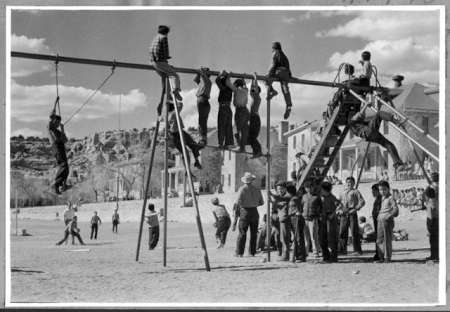
Playing outside
Recess at Keams Canyon Boarding School, 1945.
The Hopi Tribe: Snow, Milton
Repository: Hopi Cultural Preservation Office
Call Number: HCPO.PH.2003.1.HF1.16
Item Number: 28268
Photo from http://archive.library.nau.edu
photo id: 525
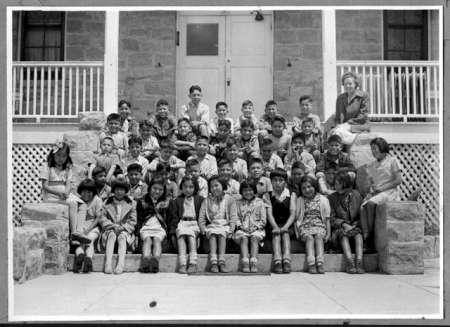
Class in Front of School
Class photograph in front of Keams Canyon Boarding School.
The Hopi Tribe: Snow, Milton
Repository: Hopi Cultural Preservation Office
Call Number: HCPO.PH.2003.1.HF1.25
Item Number: 28278
Photo from http://archive.library.nau.edu
photo id: 526
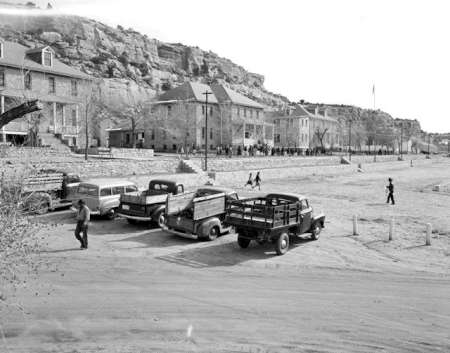
Dorms and Employees Clubs
Keams Canyon Boarding school dormitory buildings and the employees club.
The Hopi Tribe: Snow, Milton
Repository: Hopi Cultural Preservation Office
Call Number: HCPO.PH.2003.1.HE1.20
Item Number: 26322
Photo from http://archive.library.nau.edu
photo id: 527
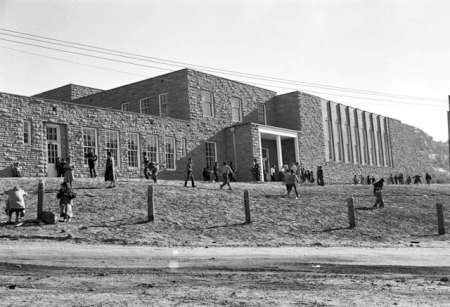
Keams Canyon School
Keams Canyon Boarding School in 1951.
The Hopi Tribe: Snow, Milton
Repository: Hopi Cultural Preservation Office
Call Number: HCPO.PH.2003.1.HE1.28
Item Number: 28795
Photo from http://archive.library.nau.edu
photo id: 528
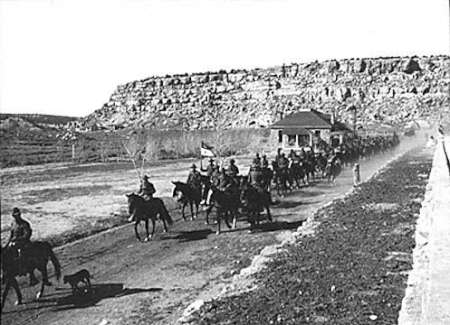
Troops in Keams Canyon
In 1863 Colonel Kit Carson and his troops were sent to help capture the Navajo Indians. Several times during their assignment they camped in Peach Orchard Springs. This area was later renamed by Thomas Keams when he returned and settled in the regions and called it Keams Canyon.
This photo of troops in Keams Canyon was taken in 1911.
Collection: Crane, Leo
Repository: Northern Arizona University Cline Library
Call Number: NAU.PH.658.675
Item Number: 697
Photo from http://archive.library.nau.edu
photo id: 538

5th Cavalry With Hostiles in Keams Canyon
The chief of the Oraibi at the time, Lololoma, was very excited about Hopi education but the Oraibi people were divided on this issue. Most of the village was conservative and refused to allow their children to attend school. These Indians were referred to as the “hostiles” because they opposed the American government and their attempts at assimilation. In 1894, a group of Hopi parents announced that they were against the ideas of Washington and did not want their children to be exposed to the culture of the White American people. They also said that this argument couldn’t be settled peacefully, so the government sent in troops to arrest the nineteen parents and sent them to Alcatraz Prison where they stayed for a year.
This photograph is of the 5th U.S. Cavalry Moki Hostile Prisoners Camp at Keams Canyon. It was taken in 1905.
Collection: Mora, Jo
Repository: Northern Arizona University Cline Library
Call Number: NAU.PH.86.1.560
Item Number: 462
Photo from http://archive.library.nau.edu
photo id: 572
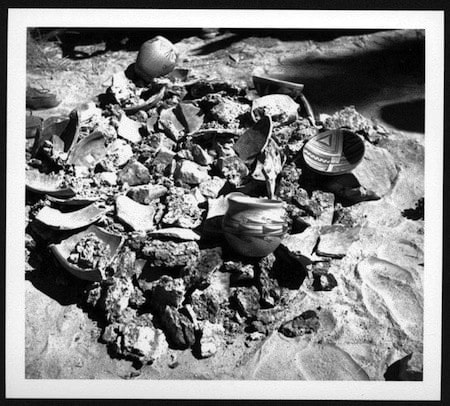
Hopi Pottery
Hopi pottery, called Hano Polychrome or Sikyatki Revival, stands out among all of the pueblo and non-pueblo pottery makers. The white wash with poly-chrome painting is one of the most recognizable art styles in the world.
The art style is different within each family of potters. Avid collectors are familiar with the Hopi pottery by artist and almost instantaneously recognize the artists.
Collection: Nichols, Tad
Repository: Northern Arizona University Cline Library
Call Number: NAU.PH.99.3.6.13
Item Number: 29669
Photo from http://archive.library.nau.edu
photo id: 1021
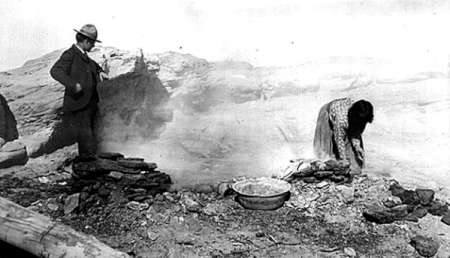
Firing Pottery
Nampeo burning pottery in Tewa, Arizona, 1905. E.A. Burbank is on the right.
Collection: Mora, Jo
Repository: Northern Arizona University Cline Library
Call Number: NAU.PH.86.1.463
Item Number: 428
Photo from http://archive.library.nau.edu
photo id: 652
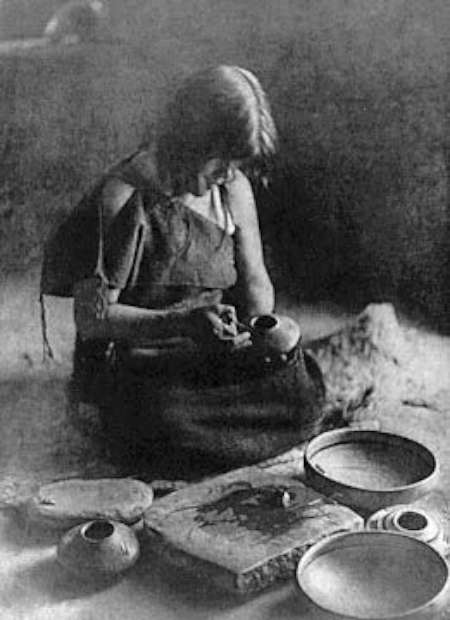
Pottery
Collection: Curtis, Edward S
Repository: Hopi Cultural Preservation Office
Call Number: NAU.PH.93.38.24
Item Number: 1625
Photo from http://archive.library.nau.edu
photo id: 656
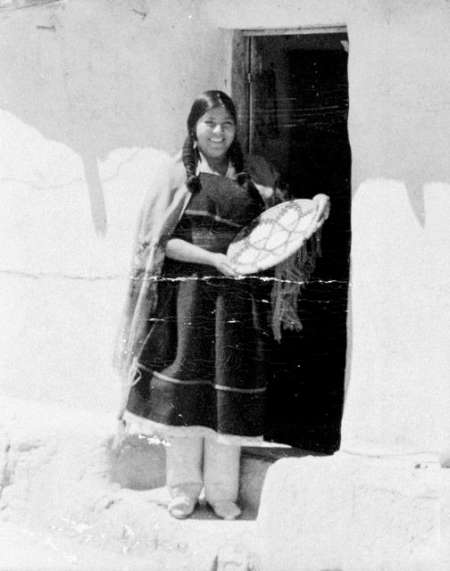
Hopi Basket
Pictured here is Rose Lynn Howee of Shungopovi Village in Second Mesa. The photo was taken in June 1944. She is holding a Hopi basket and wearing a married woman’s hairstyle. The dress and leggings are a traditional outfit.
The Hopi Tribe: Snow, Milton
Repository: Hopi Cultural Preservation Office
Call Number: HCPO.PH.2003.1.HH2.33
Item Number: 26660
Photo from http://archive.library.nau.edu
photo id: 663
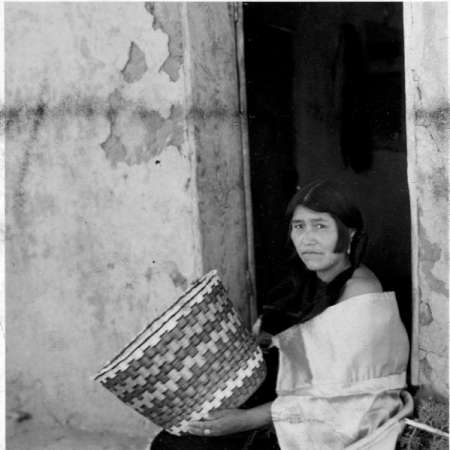
Basket of rabbit brush
The women of Third Mesa make wicker baskets of rabbit brush. This photo was taken in 1925.
Collection: Warren Family
Repository: Hopi Cultural Preservation Office
Call Number: NAU.PH.412.5.107
Item Number: 151208
Photo from http://archive.library.nau.edu
photo id: 719
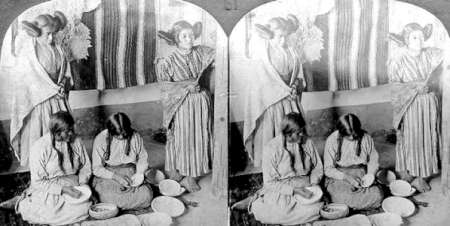
Decorating
Hopi women decorating pottery in 1904.
This is a stereoscope image. Stereoscopes were a popular device that allowed two images to become a single three-dimensional picture.
Collection: NAU General Photograph Collections
Repository: Northern Arizona University Cline Library
Call Number: NAU.PH.99.9
Item Number: 4679
Photo from http://archive.library.nau.edu
photo id: 655
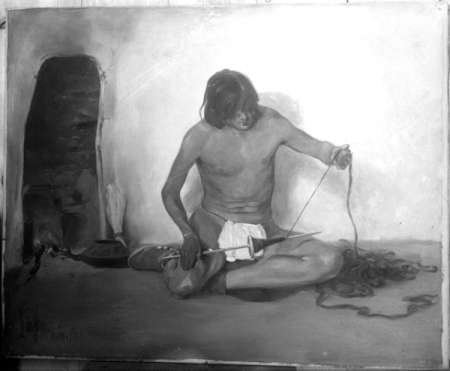
Painting of Hopi Man Spinning
This painting of a Hopi man spinning was painted by Louis Akin.
Collection: Kolb, Emery
Repository: Northern Arizona University Cline Library
Call Number: NAU.PH.568.8696
Item Number: 118403
Photo from http://archive.library.nau.edu
photo id: 667
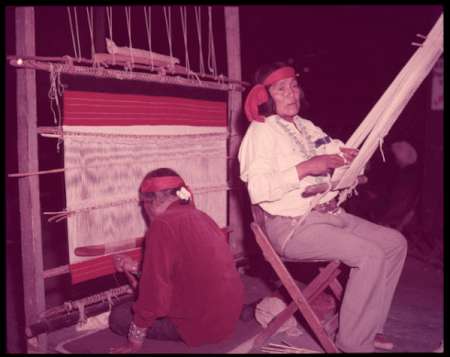
Men Weaving
Weaving is done by men rather than women among the Hopi.
Collection: Muench, Josef
Repository: Northern Arizona University Cline Library
Call Number: NAU.PH.2003.11.9.A9404
Item Number: 25670
Photo from http://archive.library.nau.edu
photo id: 668
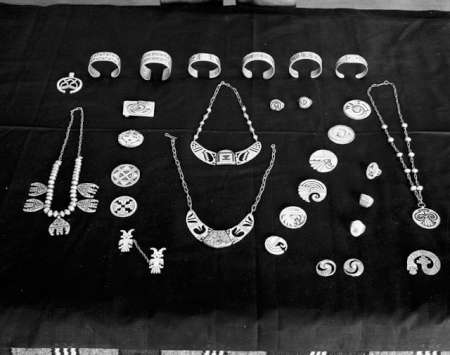
Hopi Jewelry
Hopi jewelry by the Arts & Crafts Guild on display.
The Hopi Tribe: Snow, Milton
Repository: Hopi Cultural Preservation Office
Call Number: HCPO.PH.2003.1.HC5.17
Item Number: 27248
Photo from http://archive.library.nau.edu
photo id: 677
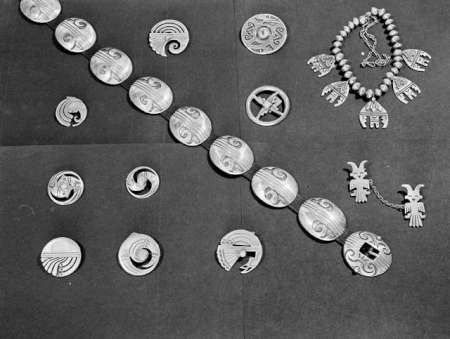
Silver Jewelry
Silver jewelry exhibited by the Hopi Arts & Crafts Guild at Oraibi High School in December 1948.
The Hopi Tribe: Snow, Milton
Repository: Hopi Cultural Preservation Office
Call Number: HCPO.PH.2003.1.HC5.18
Item Number: 27250
Photo from http://archive.library.nau.edu
photo id: 678

Jewelry design molds
The drawing, mold, cast piece and finished bracelet. This was on display with the Hopi Arts & Crafts Guild in 1949
The Hopi Tribe: Snow, Milton
Repository: Hopi Cultural Preservation Office
Call Number: HCPO.PH.2003.1.HC5.30
Item Number: 27294
Photo from http://archive.library.nau.edu
photo id: 680

Pottery and Jewelry Designs
A display of Hopi pottery and jewelry.
The Hopi Tribe: Snow, Milton
Repository: Hopi Cultural Preservation Office
Call Number: HCPO.PH.2003.1.HC5.7
Item Number: 26972
Photo from http://archive.library.nau.edu
photo id: 682
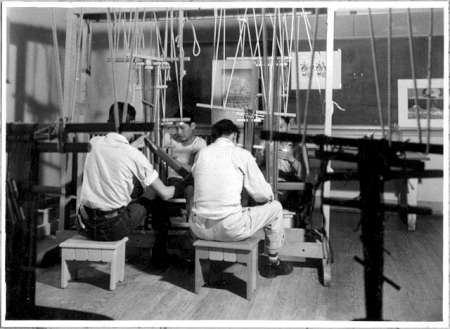
Boys in weaving class
8th grade boys in weaving at Hopi High School in Oraibi. The teacher is Fred Kabotie, and it was taken in 1945.
The Hopi Tribe: Snow, Milton
Repository: Hopi Cultural Preservation Office
Call Number: HCPO.PH.2003.1.HF2.18
Item Number: 29139
Photo from http://archive.library.nau.edu
photo id: 715
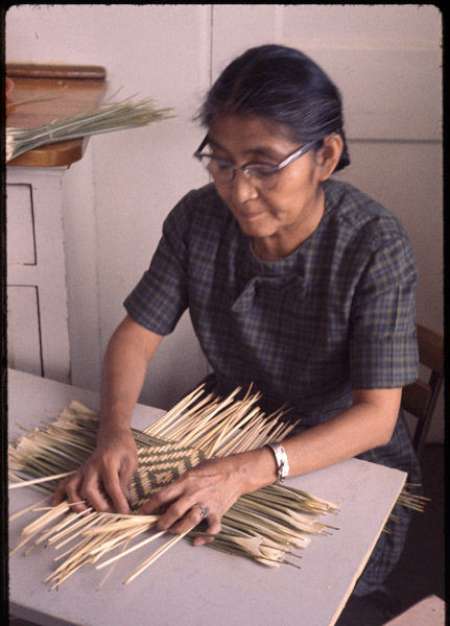
Basketmaking
Alice Kabotie makes a Hopi ‘ sifter’ basket of yucca leaves. This was taken in Shungopavi, Arizona in 1962.Collection: Belknap, Bill
Repository: Northern Arizona University Cline Library
Call Number: NAU.PH.96.4.17.30
Item Number: 2964
Photo from http://archive.library.nau.edu
photo id: 660
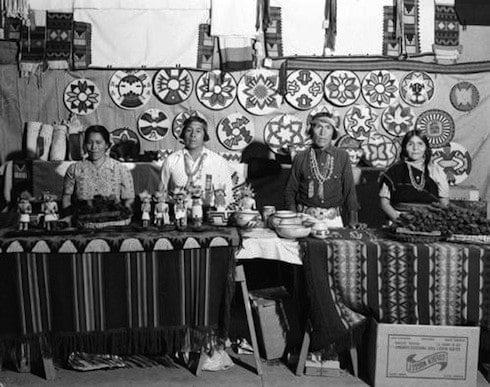
Basket Display
Display of Hopi baskets, pottery, kachinas, and bread. Pictured are Florence Koinva, Spencer Kewenvoyouma, Viets Lomahaftewa and Nellie Lomahaftewa in 1944.
The Hopi Tribe: Snow, Milton
Repository: Hopi Cultural Preservation Office
Call Number: HCPO.PH.2003.1.HC2.10
Item Number: 26724
Photo from http://archive.library.nau.edu
photo id: 837
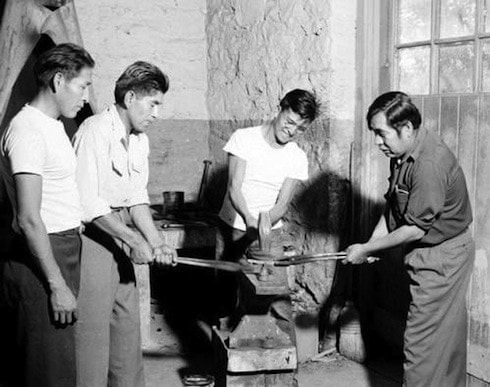
Die Making
Die making: heating & cutting a section off an automobile coil spring. Taken between 1944 and 1950.
The Hopi Tribe: Snow, Milton
Repository: Hopi Cultural Preservation Office
Call Number: HCPO.PH.2003.1.HC5.21
Item Number: 27262
Photo from http://archive.library.nau.edu
photo id: 838

Wood Carving
Jim Kewanwytewa carving a kachina, circa 1966.
Repository: Hopi Cultural Preservation Office
Call Number: AHS.0666.00230
Item Number: 8698
Photo from http://archive.library.nau.edu
photo id: 1022
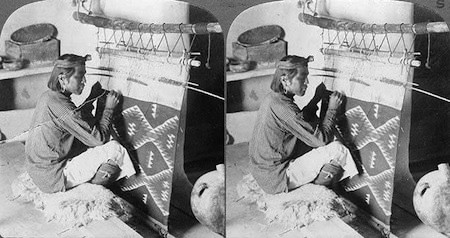
Weaving Stereoscope
A stereograph from 1910 showing a Hopi weaving in Walpi.
Stereoscopes were a popular device that allowed two images to become a single three-dimensional picture.
NAU General Photograph Collections
Repository: Hopi Cultural Preservation Office
Call Number: NAU.PH.99.60
Item Number: 5575
Photo from http://archive.library.nau.edu
photo id: 1023

